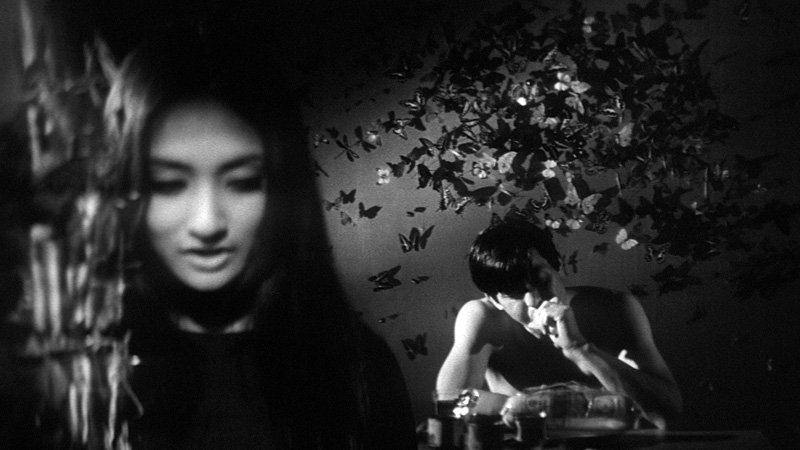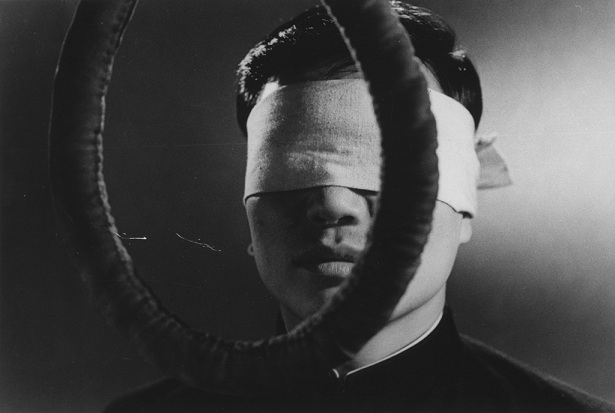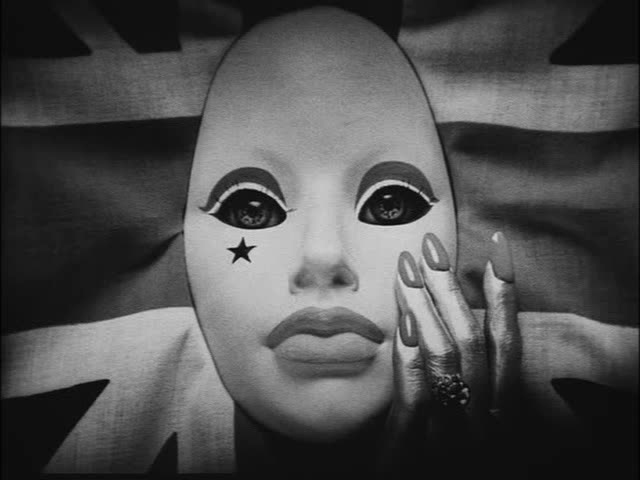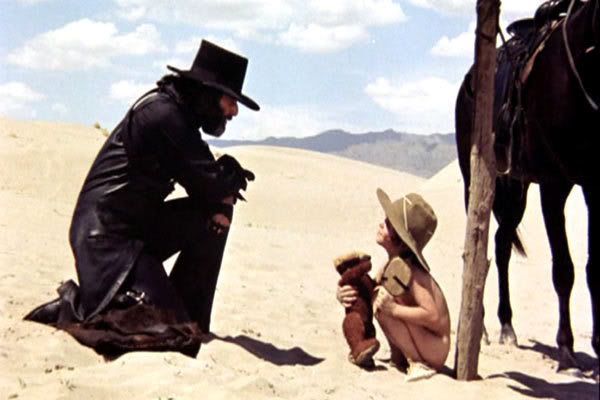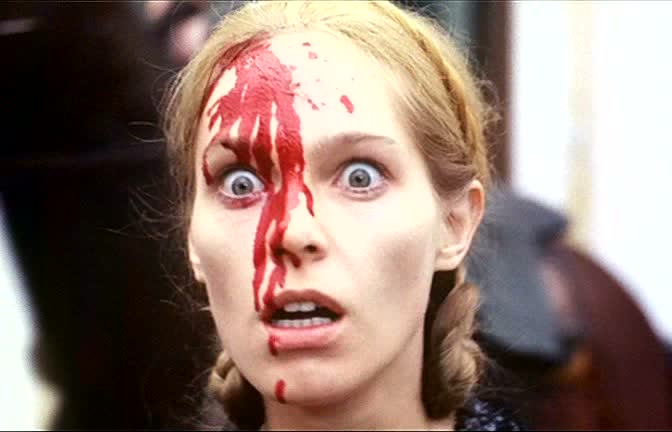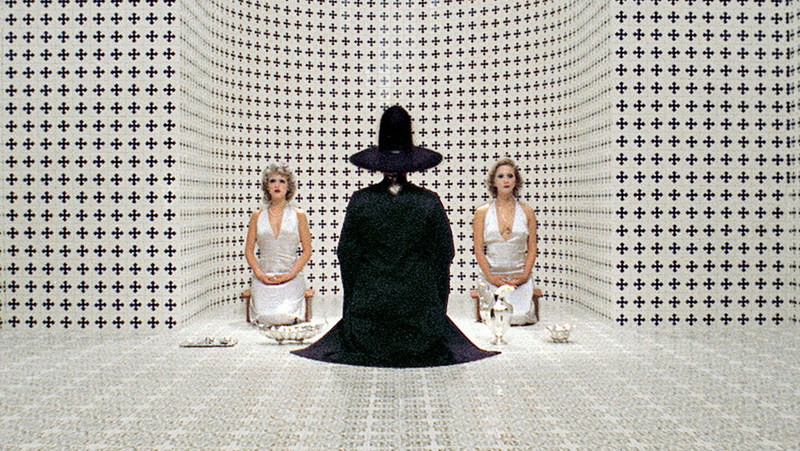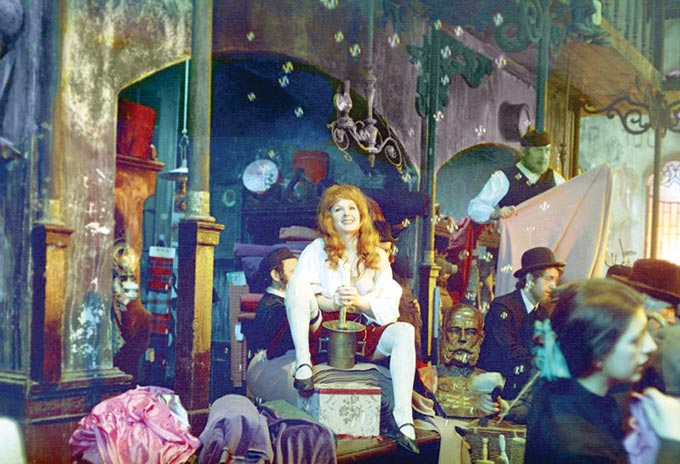8. Branded to Kill (1967) Dir Seijun Suzuki
Taking the familiar elements of a B-movie crime drama and filled it with surreal elements and action packed suspense, Branded to Kill tells the story of Hanada, the third best hit man in Japanese organized crime and his wife Mami who just flew into Tokyo to get back in the killing game, aided by Kasuga, a former high ranked hit man now turned cab driver.
Kasuga gets the couple to a bar where all things turn south. When Hanada is near the top of his game, he encounters a mysterious, seductive and death obsessed woman who brings him a near impossible mission. He accepts the mission, while on the job when he is about to execute the mark, a butterfly lands on his sight just about when he is about to take the shot, causing him to miss the target and kill an innocent bystander.
The incident leads Hanada to be demoted from his rank and become a target, he plans to leave the country but he can’t because he is shot by his wife and left for dead. He discovers why he was contracted to kill the target and ends up in a diamond smuggling operation but the big question is still left unanswered who really hired Hanada and what are his intentions.
This is one of the best examples of a cat and mouse chase in film, with unexpected twists and even a strange fetish with the smell of boiling rice. At times it is almost impossible to decipher what is happening, but thanks to the great visual aesthetics of the cinematography, the story comes out as comprehensible. At the end the story plays out less as a suspense thriller than a surrealistic, psycho-sexual fantasy.
When the movie came out, it was a commercial and critical disappointment. Suzuki was banned and blacklisted, this caused him to have a ten-year hiatus from making another film.
9. Death by Hanging (1968) Dir. Nagisa Oshima
This documentary style film introduces us to a room where an execution is about to happen, the man who is to be executed is only known by the name R, the execution proceeds and the man is executed. Mysteriously R survives, the physician examines him only to discover he is in an amnesiac state, he does not recall his crimes or why he is being convicted and executed, the officials are baffled by what just happened and debate how to proceed, pondering how the law could forbid the execution of an individual who can´t recognize his crimes.
Now the officials must do everything to persuade R to accept guilt by recognizing his crime, in an absurd scene the officials recreate R’s first crime of the raping of a young woman, the film turns into a dark comedy of sorts while the officials will do anything to trigger R’s memory.
The film is modulated to be a tragicomedy on intolerance and capital punishment, the film often uses circles in order to represent death and the circular narrative. The film also criticizes the deterioration of post war society and how one nation can end up being dehumanized and almost being blind to racism, almost appealing to the contemporary examination of social justice.
10. Funeral Parade of Roses (1969) Dir. Toshio Matsumoto
This black and white film centers on a Greek tragedy-like gay love triangle. The story sees Eddie tenaciously rising through the gay scene to become a madam of his own gay bar. Leda, a transvestite and Goda a drug dealer, who also happens to manage the bar. Both Eddie and Leda have sexual desires for him, due to some trials and tribulations of life, Leda commits suicide, leaving Eddie and Goda free to engage in their homosexual yearnings for each other, leaving both to discover a gruesome truth that will change their lives forever.
The story is a tragedy in every sense of the word, with an aura of Hitchockian suspense that delights us at moments, having a playful and evasive attitude towards homosexuality that ultimately delivers the viewer to follow a tragic trajectory that follows homosexuality born from violence and trauma. Stanley Kubrick cited this film as a direct influence on his film A Clockwork Orange.
11. El Topo (1970) Dir. Alejandro Jodorowsky
El Topo is one of the most known films in Alejandro Jodorwsky’s history as a filmmaker. The story is divided into two sections, the first part of the film could be called a Western, much of its story and way of filming resembles the great golden age of Westerns. The film follows El Topo, brilliantly played by Jodorowsky himself, and his naked son also played by his son in real life.
While on a journey through the desert, they come across the remains of townsfolk who have been slaughtered by a man named The Colonel. Leaving his son behind with some monks, El Topo is now on a mission to track and kill The Colonel, El Topo now aided with the help of a woman who was a former slave of The Colonel who he calls Mara. Mara convinces El Topo to defeat and kill four great gun slayers so he can become the greatest gun slayer in the land, following a path of violence and the ultimate search for redemption, just to be betrayed at the last second.
In part two of the film, El Topo is in a state of animated suspension state while meditating on the four lessons he learned from the gun masters, deformed outcasts who live and are trapped in a cave have been taking care of him and nursing him back to good health. The outcasts worship him almost like a God-like figure, he realizes several years have passed since the last time we saw him and he decides he will help the outcasts escape, a new priest arrives and finds out he is El Topo’s son who he abandon several years before with the monks he decides he will kill him once he helps the outcasts break free.
El Topo has started a relationship with a dwarf girl who is now pregnant with his son. With the help of his new pregnant lover and his son, El Topo makes a new exit so the people can escape just to find themselves in a bigger problem where all hell breaks loose.
This movie is great because each gunman represents different philosophies and religions, the movie centers on a journey of self-discovery and awareness to different cultural experiences, but ultimately it is a journey of redemption gone wrong, and how El Topo tries to do right to his every wrong, but ultimately the universe is set to punish him and teach him a lesson.
12. The Third Part of The Night (1971) Dir. Andrzej Zulawski
Set in World War II during the Nazi occupation of Poland, this is one of the best examples of mistaken identity on film. A young man named Michal watches how German soldiers slaughter his wife, son and mother as he narrowly escapes the same fate by hiding in the forest.
He decides to join the resistance where he was a former member, while in town the German soldiers mistake another man for Michal, shooting him and taking him prisoner in Michal’s place. He ends up in this man’s house and ends up helping his wife who resembles his late wife.
Thinking over and over again, Michal finds it hard to believe everything he just experienced is just a mere coincidence, analyzing the situation further he sees an open window for redemption and takes it upon himself to take care of the woman and child. Taking a job in the typhus center, where he acts as a human guinea pig for lice. Finally he takes it upon himself to find the man who was mistaken for him.
Filled with apocalyptical imagery and the psychosis of World War II decay, the film re-tells the troubled childhood Andrzej witness, detailing his father’s personal and traumatic experience in a war stricken environment. It is also an emotional journey into madness and hysteria.
13. The Holy Mountain (1973) Dir. Alejandro Jodorowsky
This movie is hard to comprehend from the start, it is full of hidden symbolism and unexpected philosophy. The story follows a thief who goes into the city to make money from tourists, but in return is exploited because of his striking resemblance to Jesus Christ, he now inspires some to use his likeness to replicate a doll of Jesus Christ. Offended by it, the thief eats off the face, straps on some balloons and sends him literally to the heavens.
After some time he sees a small crowd gather around a tower, finding out that someone has sent down gold in exchange for food. Wishing to find the source of the gold, he climbs the tower and finds an Alchemist played by Jodorowsky, who takes him under his wing as an apprentice after testing him, he introduces him to seven people who represents the planets in our solar system and set off to find immortality from the nine immortal masters who live in the holy mountain.
The movie speaks for itself, sometimes incomprehensible and incoherent, a satire against consumerism and religion in a way, with grotesque and dreamlike sequence that criticize modern society, it is almost impossible to find a film that breaks through the fourth wall and leaves the audience defying themselves.
14. The Hourglass Sanatorium (1973) Dir. Wojciech Has
Joseph begins a journey into a dream-like world to visit his dying father who now resides in a sanatorium. Arriving at the facility he discovers the place in ruins, no one is in charge, and no one seems to care for its patients. Time appears to have different sets of rules in this place, while on the place Joseph befriends Rudolph, a young boy carrying a stamp album that triggers his memories into a journey of adventure.
In this phantasmagorical funhouse, Director Wojciech takes us into a wild ride through a man’s memories, encountering scenes from his childhood and the remnants of Poland’s Jewish community. A train driver that is a direct allegory to death and the constant reminder that death is always watching and luring from different places. The film is an ode to pre and post war Jewish laments rendered extinct by German authorities.
15. Celine and Julie Go Boating (1974) Jaques Rivette
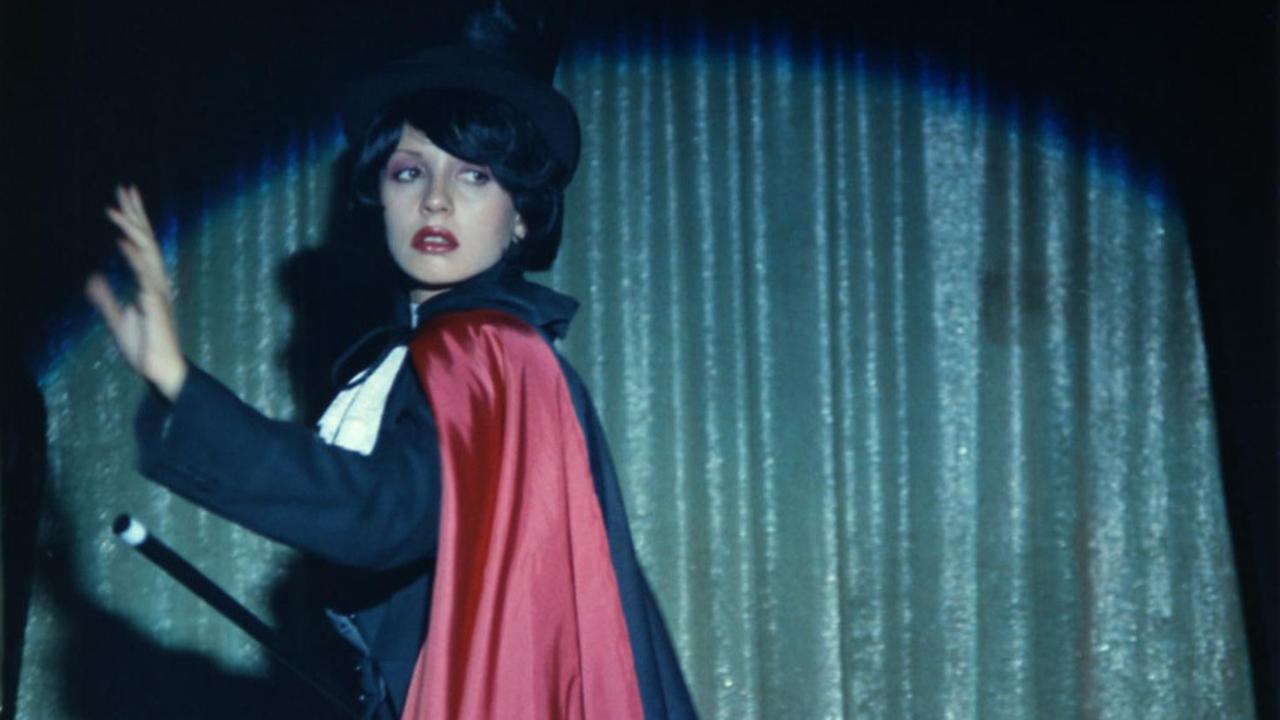
This Brilliant film is a perfect example of a story about storytelling, while the film might as well be a reinterpretation or an ode to Lewis Carroll’s Alice in Wonderland where the two main characters Celine and Julie go from one story to another, filling each other’s minds with stories and finding it almost impossible to tell if the story was made-up or if indeed the story was real, finally fulfilling their destiny and becoming the heroine’s in their own story.
By far this might be one of the most imaginative and distinctive films out there, with its surreal storytelling, and a parallel universe where everything is possible.
